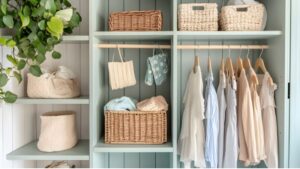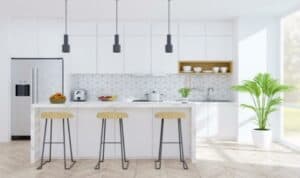
Historical and Cultural Significance
As you delve into the heritage of credenzas, buffets, and sideboards, you’ll discover their unique roles and adaptations across times and cultures.
Credenzas Through Time
Originating in 14th century Italy, the credenza was a symbol of trust and safety. It was a place where food was stored and tested for poison before being served to the nobility. Over centuries, this furniture piece evolved not just in function but also in its design, reflecting the aesthetic shifts of Italian culture.
Buffets and Their Evolution
The buffet comes from Swedish origins, where it was used to serve smorgasbords. Its popularity surged in France during the 18th century, signaling wealth and hospitality in grand dining halls. The French adaptation of the buffet became a staple in Europe for its practicality in serving food and displaying items of social or cultural significance.
The Sideboard’s Journey
The English version of the sideboard solidified in the 19th century. Found in middle-class homes throughout England, it served as a signifier of social status while offering practical storage and serving space. The sideboard’s versatility and presence in the dining room showcased the English’s commitment to formality and function in their household furniture.
An Overview of Credenza, Buffet, and Sideboard
When you’re perfecting your dining room or living space, understanding your furniture options is key. A credenza, buffet, and sideboard are similar pieces designed to offer ample storage, but each plays its own unique role within your home environment.
Credenzas is used in America to refer to a type of dining room cupboard that is typically used for serving buffet-style meals. They are known for their sleek, modern look and often feature sliding doors. Typically, credenzas sit lower to the ground and can be used in various rooms, from your office to the living room, making them versatile additions to your decor.

- Position: Living room, hallways, office
- Features: Sleek, modern, sliding doors
- Height: Low to the ground
Buffets originally were used to lay out food for buffet-style dining, which is why they are usually higher to allow comfortable serving. With their taller legs, buffets become focal points in a dining room and are dedicated more to serving rather than just storage.
- Position: Dining room
- Features: Taller legs, suited for serving
- Height: Tall
Sideboards are the all-rounders and can be similar to both buffets and credenzas. Typically, they have short legs or sit directly on the ground, and provide plentiful storage space. Their surface can serve as a display area in dining rooms, kitchens, or even in wide hallways.

- Position: Dining room, kitchen, hallways
- Features: Short legs or no legs, versatile storage
- Height: Low to ground or slightly elevated
Each type of furniture brings its style and function to the space you choose to place it in. Whether you value form, function, or a mix of both, one of these stylish storage cabinets will suit your needs.
Design Characteristics and Functionality of Credenza, Buffet, and Sideboard
In this section, you’ll explore the specific materials and craftsmanship that define credenzas, buffets, and sideboards. You’ll learn about the design variations between these pieces and the functional aspects that make each one unique in terms of storage and style.
Materials and Craftsmanship
Credenzas, sideboards, and buffets are often crafted from durable materials like wood and metal, with details and finishes that can range from simple and modern to ornate and traditional. The choice of material not only contributes to the piece’s aesthetic but also to its longevity and usability in your home. For example, a wooden credenza with glass cabinet doors can offer a blend of classic style and modern appeal, making it both attractive and functional.
Functional Aspects of Storage Furniture
Each furniture type offers unique functional benefits:
- Credenzas: The ample surface area is suitable for displaying decor or serving as a TV stand, while the interior shelving can store everything from linens to media devices.
- Buffets: Focus on serving and dining storage needs, with space for dishware and cutlery on top or inside, making it ideal for buffet-style dining setups.
- Sideboards: A multipurpose storage unit that can be placed in a hallway or dining area, it’s functional for storing various items and can be decorative as well, often featuring attractive finishes and hardware.
Placement of Credenza, Buffet, and Sideboard in Home Interiors

When selecting furniture like credenzas, buffets, and sideboards for your home, it’s important to consider their functionality and how they’ll complement the aesthetics of your space. Each piece can serve distinct purposes in various rooms, whether it’s for storage or display.
Fitting into the Dining Room
In the dining room, sideboards and buffets are your go-to pieces. They are perfect for serving during meals or as extra surface space to display decanters, dishes, or even floral arrangements for that added touch to your dining room decor.
Adapting for Living Rooms and Entryways
Your living room or entryway can benefit from a credenza’s sleek profile, offering a stylish yet unintrusive backdrop for your sofa or as a chic console in your hallway. Credenzas provide ample storage without taking up too much visual space, making them an excellent choice in tighter spots like hallways or smaller living rooms.
Multi-functional Uses in Various Rooms
Credenzas, sideboards, and buffets are not just confined to dining rooms or entryways; you can repurpose them across different rooms to suit your needs. Imagine using a low-profile credenza as a media stand in your bedroom, or transforming a sideboard into a bookcase or display surface — the possibilities in interior design are limitless. These versatile pieces integrate well into your home, not only as dining room furniture but also as functional elements in your overall decor scheme.
Usages Beyond Storage
Beyond their practicality, these pieces of furniture offer creative ways to enhance your living space and hosting experiences.
Hosting and Serving
When you have guests over, a sideboard or buffet serves as an ideal spot to lay out appetizers, entrees, or desserts. You can utilize the expansive top surface to arrange serving dishes in an accessible manner, allowing you and your guests to effortlessly serve and enjoy food.
Displaying Decor and Accessories
Your credenza, sideboard, or buffet can be a stage for beauty and character. By arranging fine china, tableware, or artistic accessories, you transform these items from mere storage to a display that captures attention and compliments the aesthetic of your space.
Adapting to Different Roles in the Home
The versatility of these pieces allows them to take on various roles. In the dining room, a sideboard or buffet can be a secondary serving surface. In the living area, they make for a sophisticated media center. Even in a hallway or office, these pieces can store essentials while displaying items that reflect your personal style.
Modern Adaptations and Trends of Credenza, Buffet, and Sideboard
As you explore the current landscape of furniture, you’ll notice that credenzas, buffets, and sideboards have evolved to fit modern lifestyles and aesthetic tastes. These adaptable pieces not only meet storage needs but also align with contemporary design trends and environmental consciousness.
Credenzas as Media Consoles and Office Furniture

Credenzas have found a new role in your living space as a sleek media console table, offering a stylish platform for your TV stand while smartly hiding away cables with built-in cord management features. Many designs incorporate a minimalist aesthetic with sliding doors for a clean look that complements a modern home office. They’re often equipped with ample shelves, making them a practical choice for an office setup.
Eco-Friendly and Sustainable Options
As sustainability becomes more important, you’ll be pleased to find buffet tables and sideboards made from eco-friendly materials. Look for options that use reclaimed wood or sustainably sourced materials, which not only reduce environmental impact but also add a story to your furniture. Manufacturers are increasingly focusing on creating pieces that are both beautiful and kind to the planet, so you can feel good about your purchase.
How to Select the Right Piece for Your Home
In choosing between a sideboard, buffet, or credenza, you’ll want to consider how the size, style, and build quality fit with your home’s aesthetics and functional needs.
Considerations Based on Room Size and Decor
When assessing the size of your room, remember that sideboards tend to be versatile due to their waist-high construction and may include a hutch for additional storage. They are well-suited for your living room or dining room, especially in a home where space is at a premium. If you have a large dining area, a buffet with its longer legs and heightened stature provides a commanding presence and can serve as a focal point during meals. Credenzas, with their low profile and extended surface, are great as a stylistic choice in a mid-century modern decor or whenever you require a sleek look without sacrificing functionality.
In terms of decor, select a piece that complements your existing furniture. For a cohesive look, match woods or finishes with other pieces in your room. If your dining table is dark walnut, consider a sideboard or buffet in a similar finish to create harmony. If you’re daring, a contrasting credenza can make a bold statement and add depth to your decor.
Quality and Durability of Different Manufacturers
Quality and durability are paramount when it comes to selecting the right piece. High-quality manufacturers will provide furniture that lasts, ensuring your investment is sound. Look for materials like solid wood for enduring strength and seek out joinery techniques like dovetail or mortise-and-tenon, which are hallmarks of well-crafted pieces.
- Solid Wood: Durable and can be refinished.
- Veneers: Cost-effective but less durable than solid wood.
As you narrow down choices, consider how the piece will work functionally in your home. If frequently hosting dinners, choose a buffet or sideboard that provides ample top space for serving dishes. Those with limited space might lean towards multi-functional pieces like a credenza, which can double as a TV stand or an entryway table due to its narrow depth and stylish design.
Frequently Asked Questions
What’s the difference between a credenza, a buffet, and a sideboard?
A credenza typically features a low profile with sliding doors and is often used in office settings, whereas a buffet is designed for serving food with a spacious top and storage below, and sideboards, while similar to buffets, can have cabinets, drawers or shelves and might be used in various rooms for general storage.
How do I choose between a sideboard and a credenza for my dining room?
When selecting furniture for your dining room, consider a sideboard if you need ample storage and surface area, or opt for a credenza, often found in modern designs, if you’re going for a sleeker look with potentially less storage capacity.
Can a console be used interchangeably with a sideboard or credenza?
While consoles often have a similar shape and function and can be repurposed, they’re generally narrower and may not provide the same amount of storage or surface space as sideboards or credenzas.
What are the typical uses for a credenza in modern home decor?
In modern home decor, a credenza is versatile: it may serve as a stylish storage option in living spaces, a media stand for your TV, or an additional surface in an office to organize supplies and equipment.
What are the height standards for a buffet cabinet?
Buffet cabinets generally stand at waist level, about 30 to 36 inches tall, to facilitate serving food and display items comfortably.
How does an antique credenza differ in style from contemporary pieces?
Antique credenzas often boast ornate details, rich woods, and intricate craftsmanship, contributing to a classic aesthetic, whereas contemporary credenzas tend to favor minimalism, clean lines, and modern materials for a more streamlined appearance.






